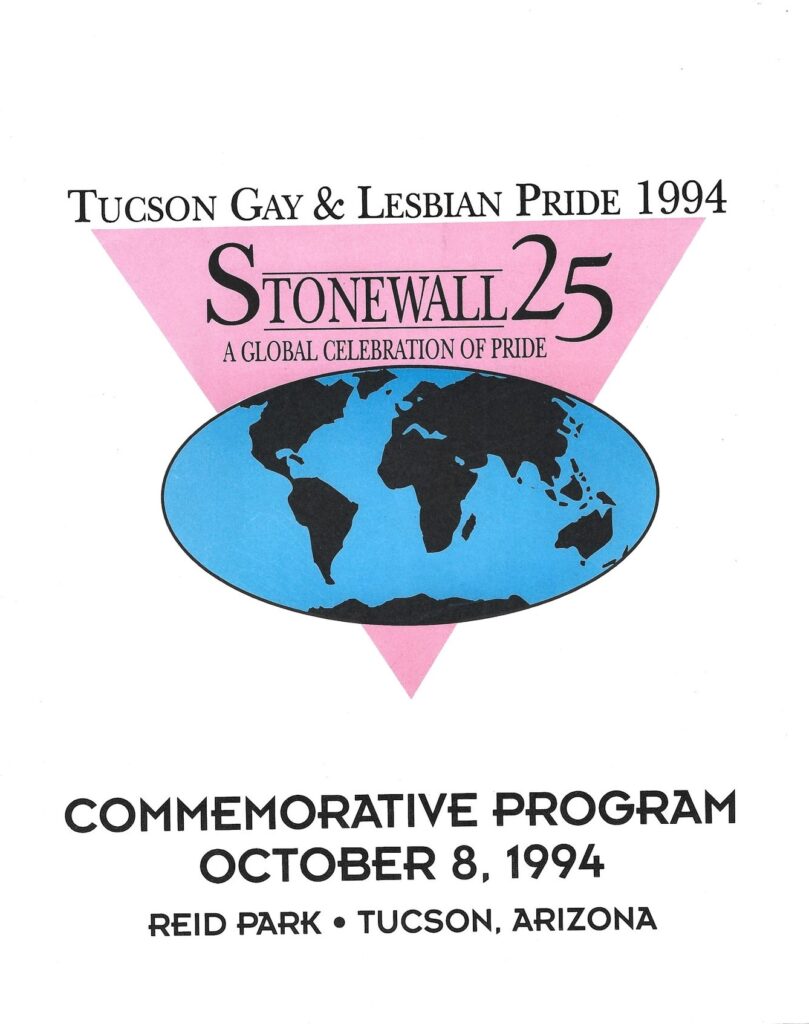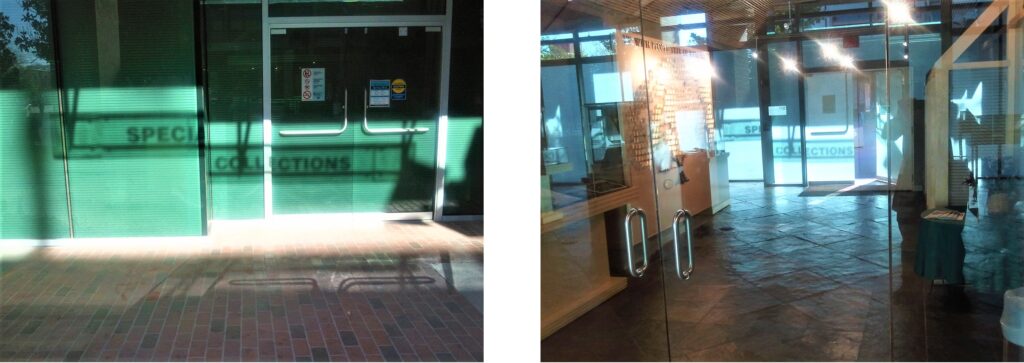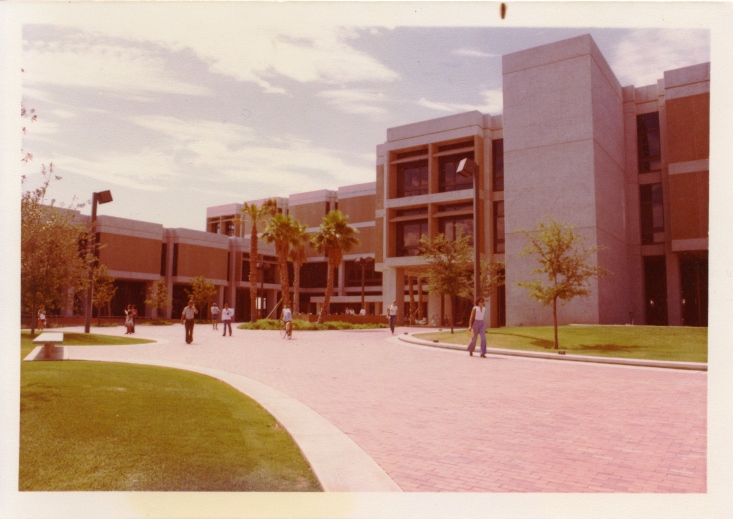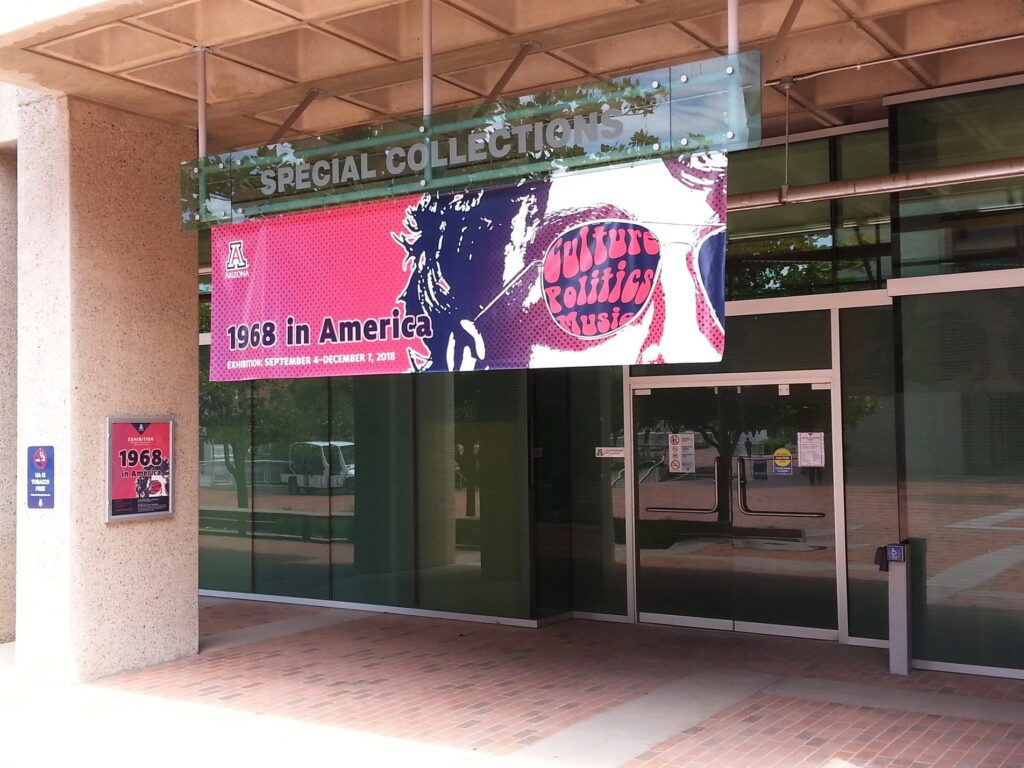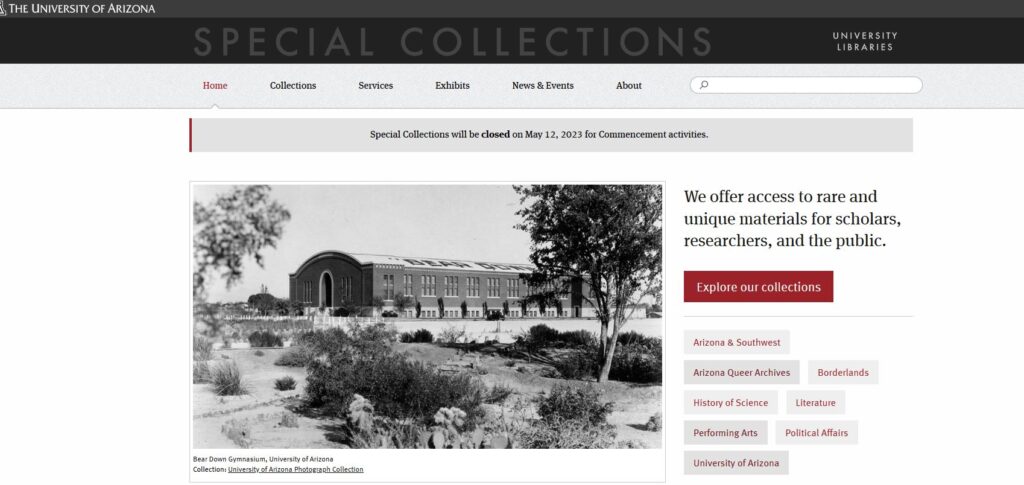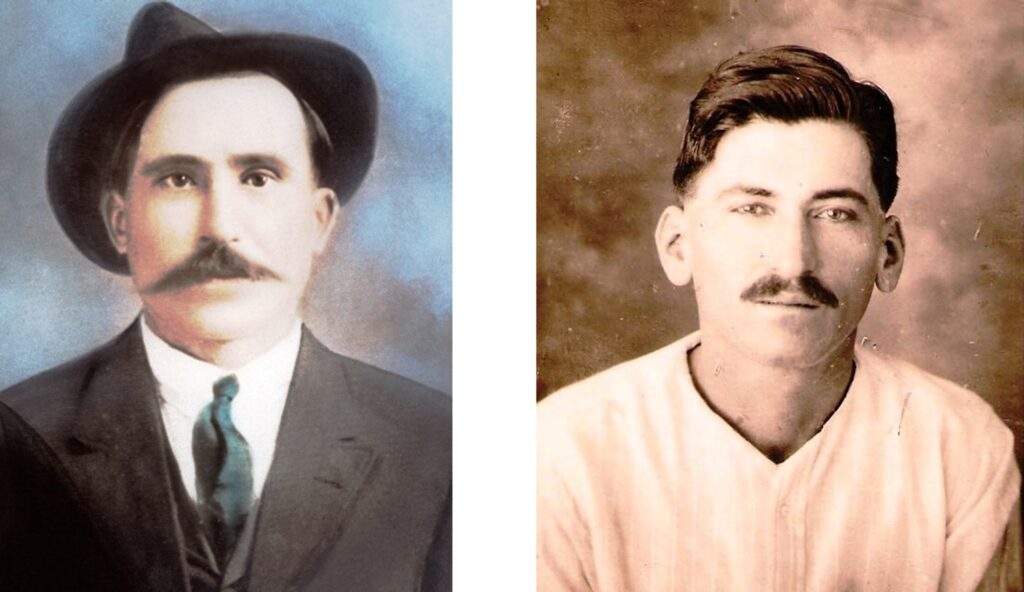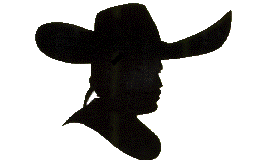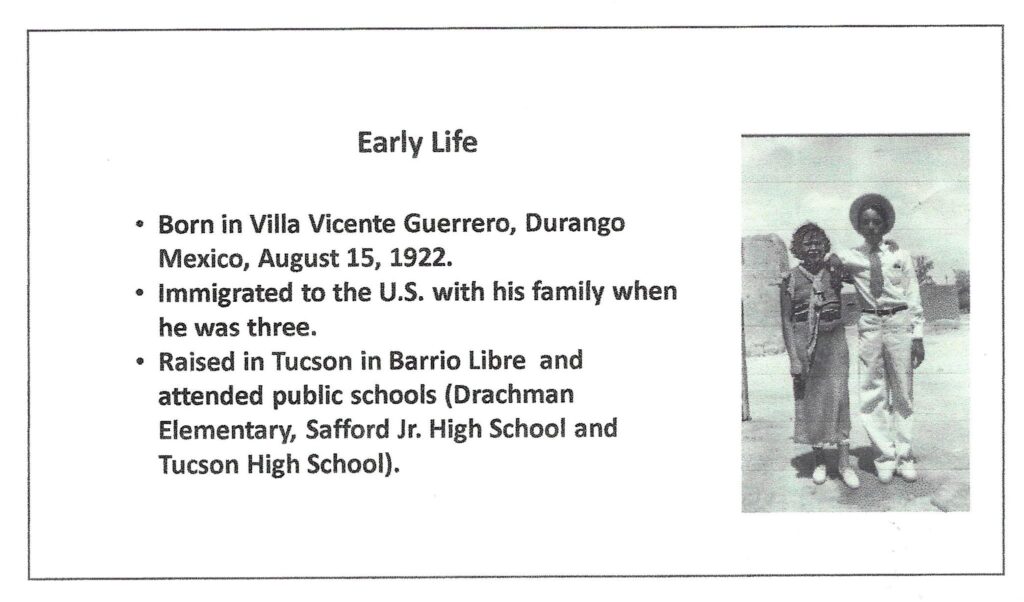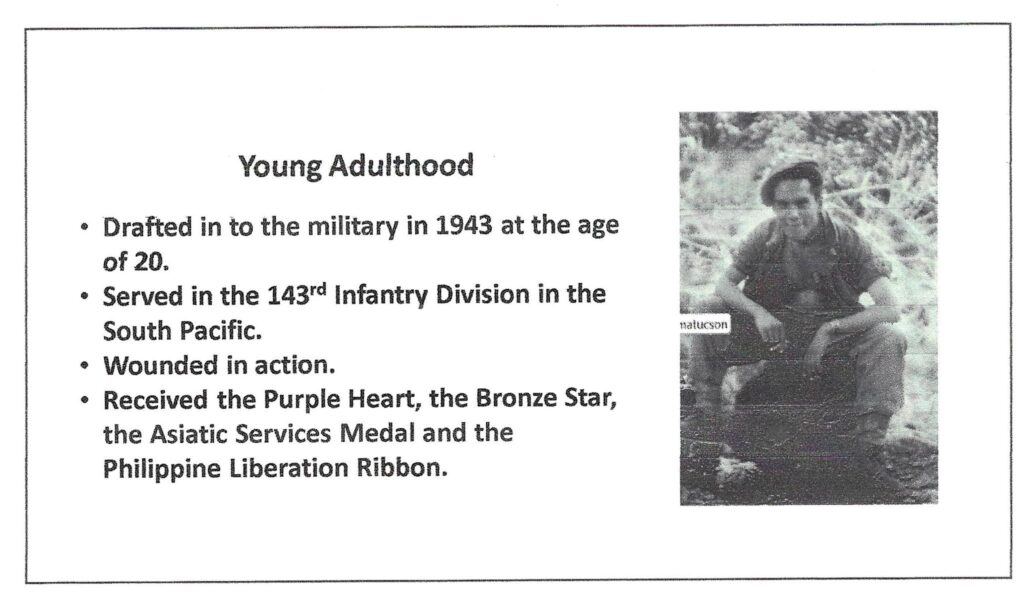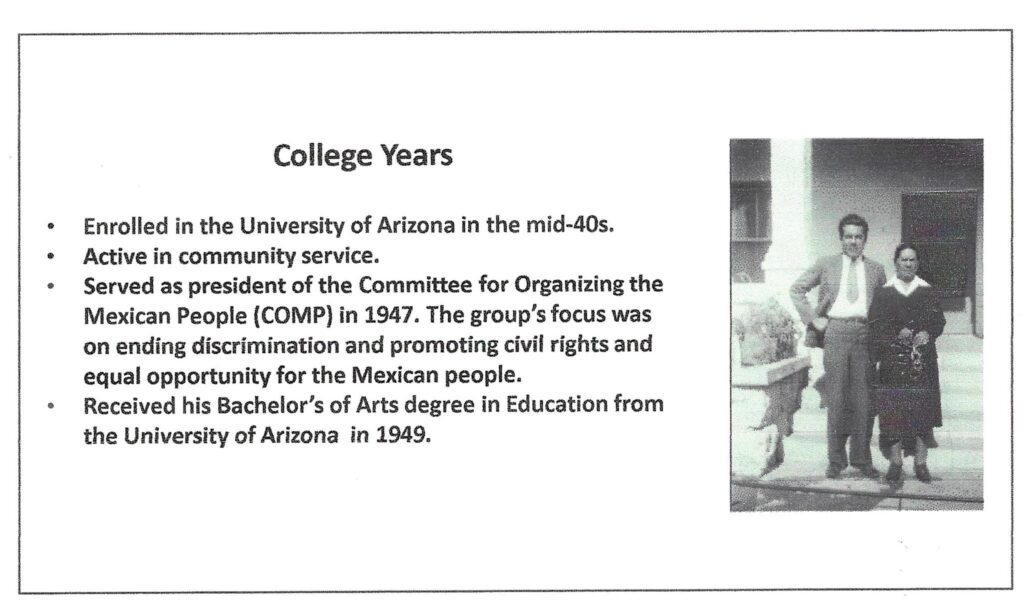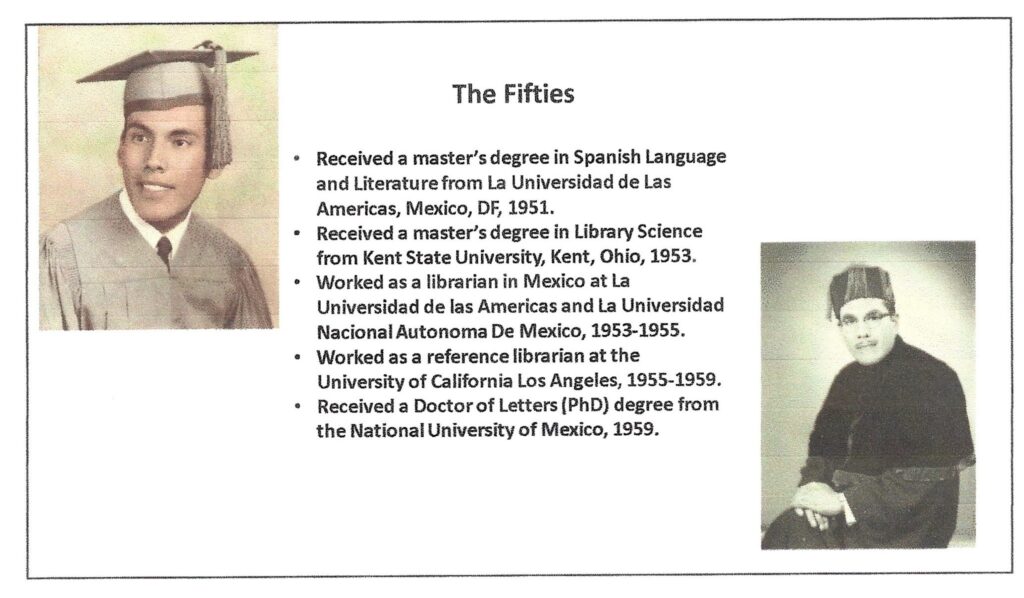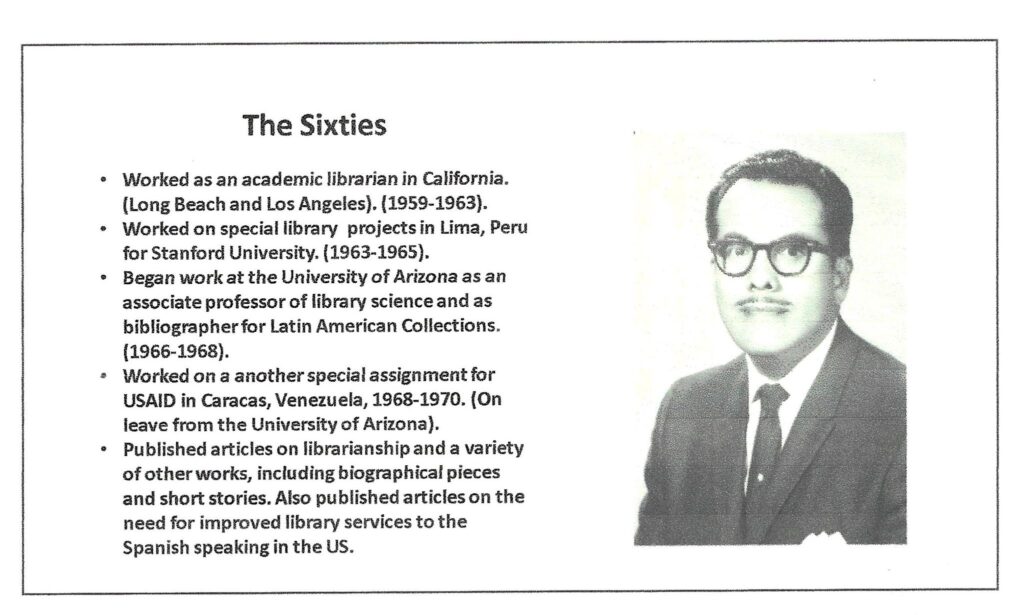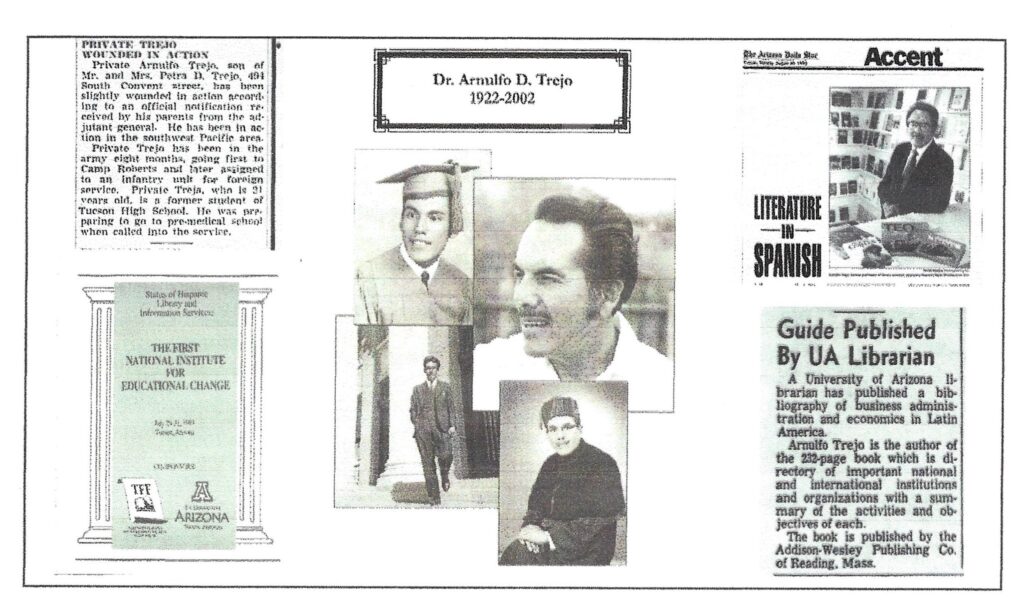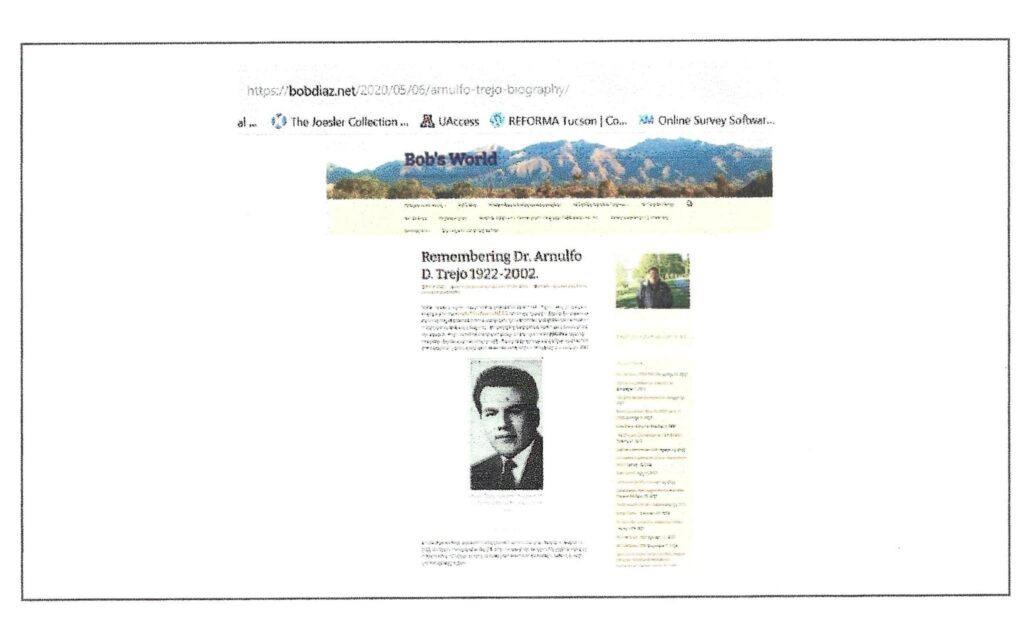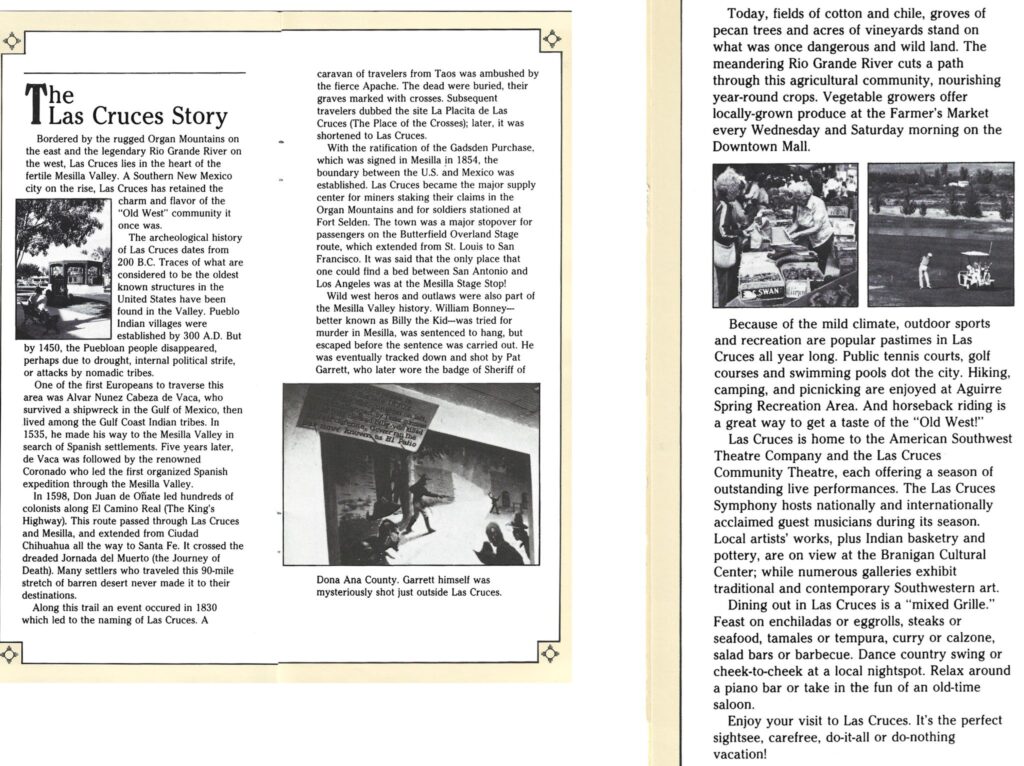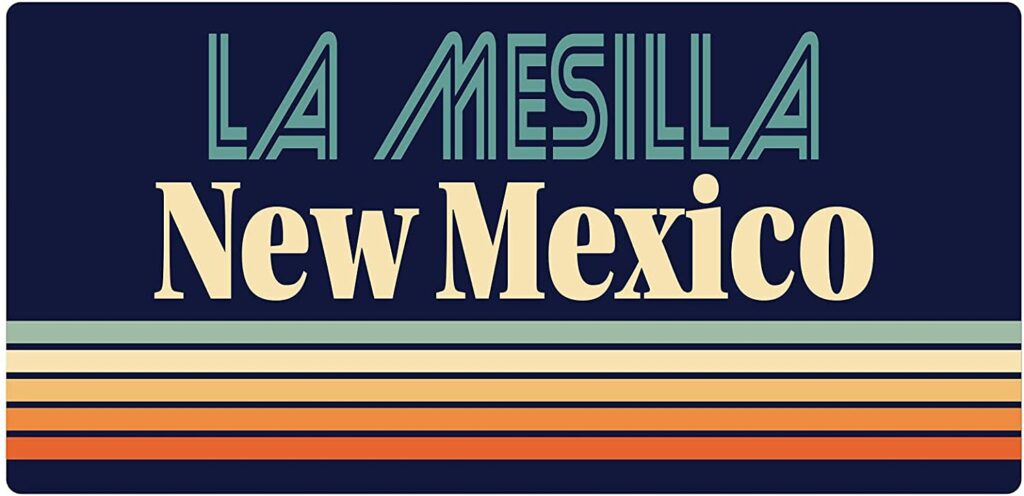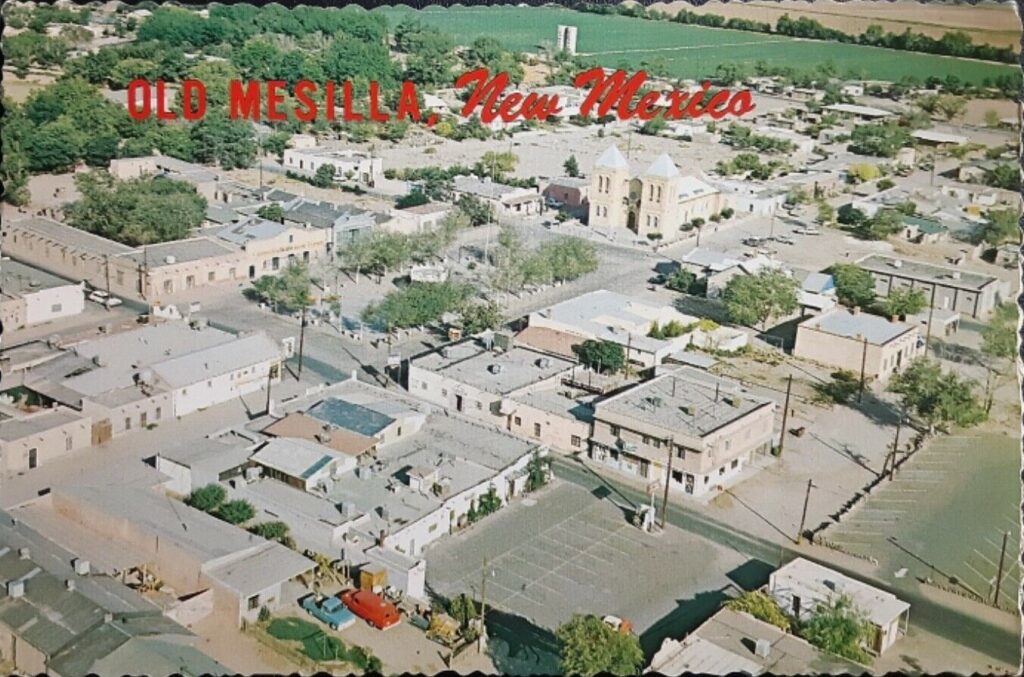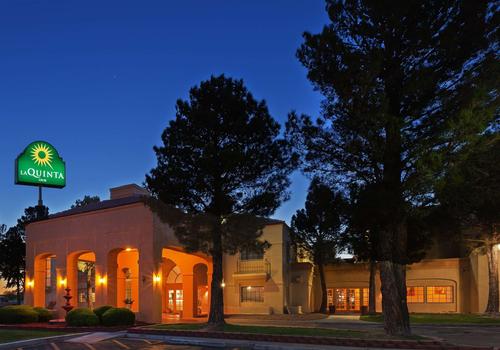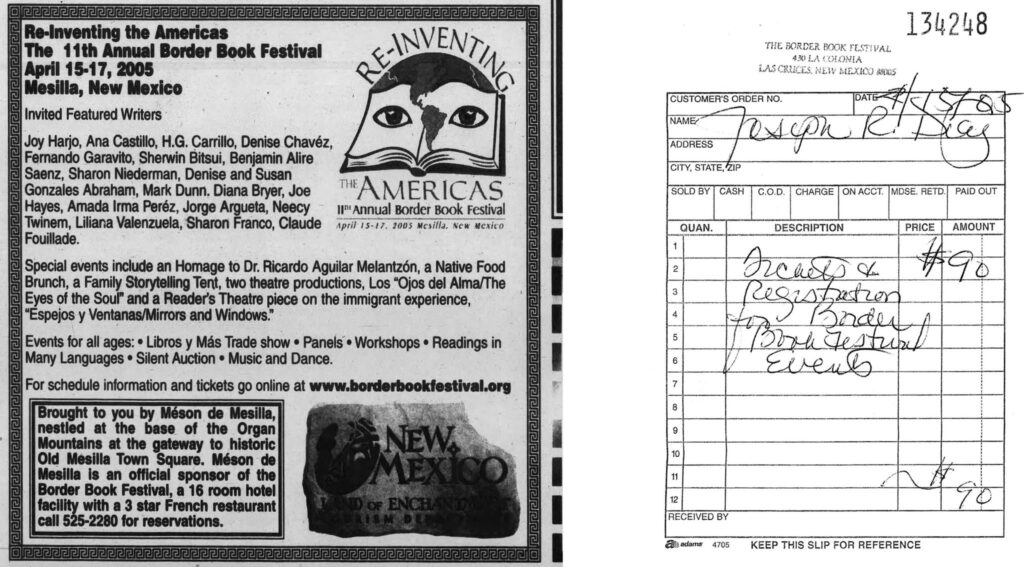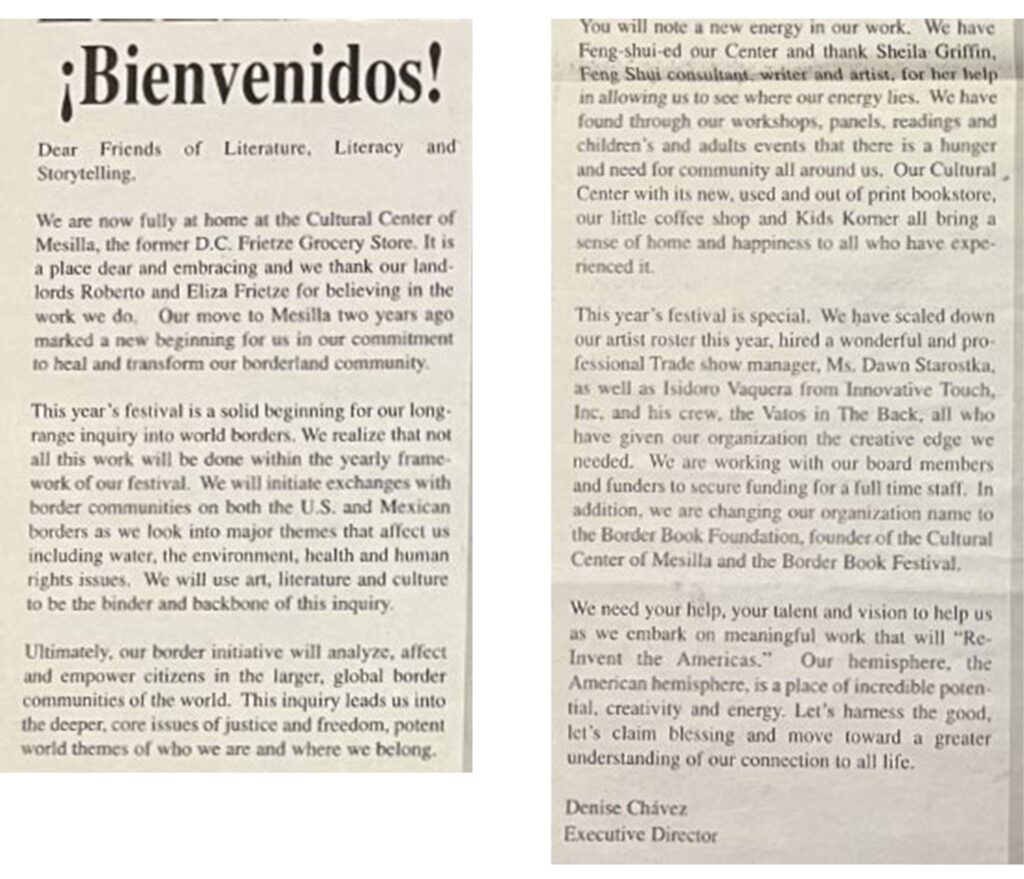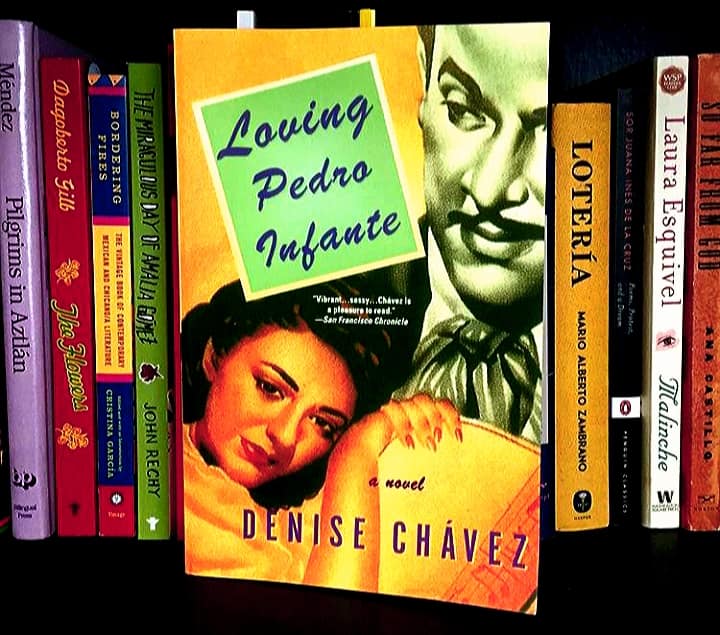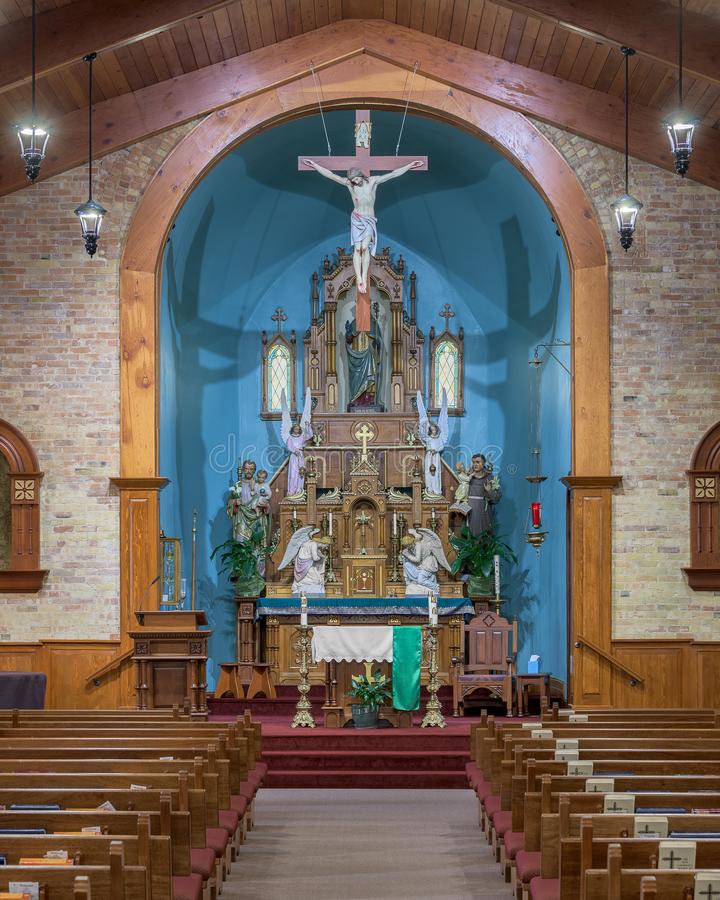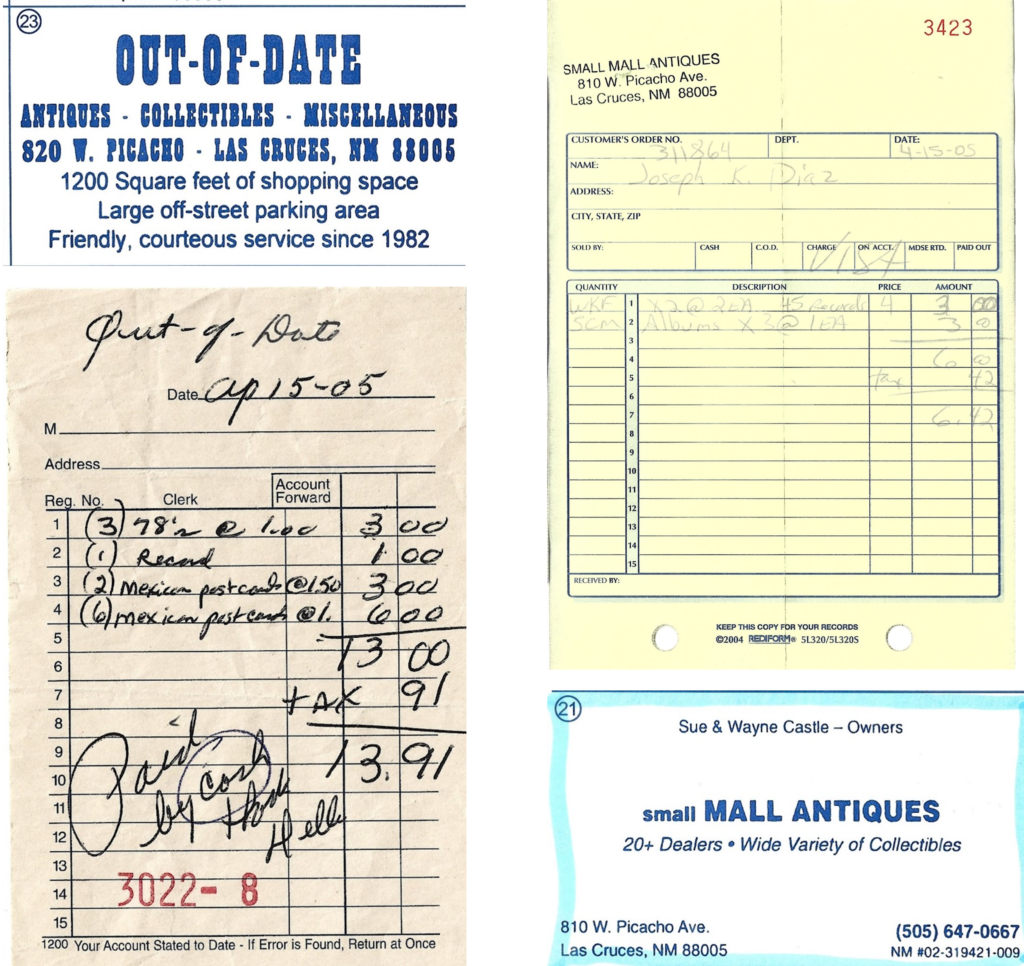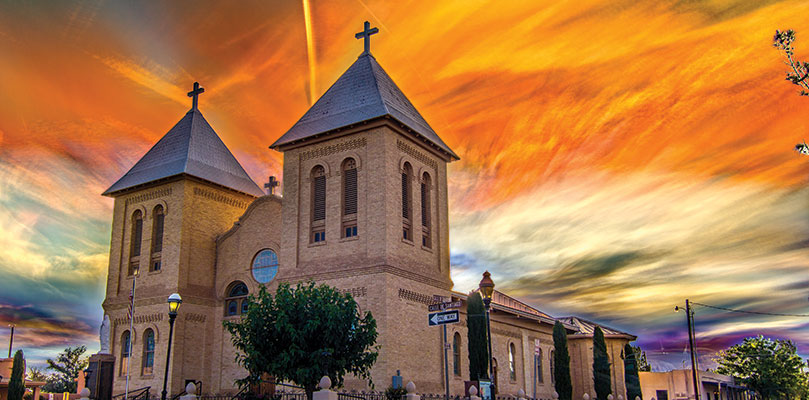Category Archives: Community events
Genealogical Resources available in Special Collections at the University of Arizona 5/10/23
Welcome to the University of Arizona, the University Library and Special Collections!
What I will cover in today’s session:
Today I am going to provide an introduction to the UA Libraries and how to access materials using our online website and other tools. More specifically, I will focus on materials housed in Special Collections. I will also give you the opportunity to get some hands on experience using our materials, and if there is time, we will take a brief tour of the facility. By the end of today’s session, you should be able to know what kinds of information you can find here, as well as how and where to look for and locate materials that will aid you in your genealogical research.
About the University of Arizona Libraries
We are a major research library with a strong focus on Latin America and the Southwest. We’re also a major repository for federal government information. We have millions of items, including books, journals, documents and materials in every format imaginable. For the past 15 years or so our emphasis has shifted from a focus on building physical collections to providing access to collections via regional and national consortia or electronic access. We provide access to newspaper and journal/magazine literature through our subscriptions to various online indexes and full-text journal collections. We invest a lot of funds into Inter-library Loan.
For more information about our library see our “About Us” page and our page on UA Library history.
About Special Collections
Established in 1958, Special Collections is home to rare books, archives, and manuscript collections, photographs, maps and multimedia materials owned by the University of Arizona Library. We have primary research material in a wide variety of subject areas, including these areas of particular focus: Arizona and the Southwest, with a strong emphasis on mining and ranching, the U.S.-Mexico borderlands, literature, political affairs, the performing arts, the history of science, University of Arizona history, and architecture. We are currently open to the general public Monday through Friday from 9am to 4pm. One need not make an appointment to visit, but it is strongly encouraged that one be prepared with lists of materials to request before arriving. We have limited staffing available at our front desk and prefer to have patrons make appointments with individual specialists in advance if in-depth assistance is required. To find a specialist in your area of study, contact us using our online research request form, available here.
Community member access to the UA Libraries
Our libraries provide a wealth of information and for the most part, as tax-paying, community members you have access to all of it.
Community members can:
- Use non-reservable spaces at the libraries during public hours
- Request a computer card to use the 6 public computers at the Main Library
- Use library databases when logged into the UAGuest wireless network anytime at any location on campus
Community members can also apply for a library card ($50 per year) to check out up to 25 books, journals, and documents at a time and use additional computers at the library. You can also place holds on materials.
Community members cannot remotely access databases, borrow laptops and technology, or reserve rooms and spaces, even with a library card.
The UA Libraries Website (https://lib.arizona.edu/)
The UA Libraries website is your gateway to the world of information. The more comfortable you are navigating it, the easier it will be to find materials in our collections and beyond. The key to mastering how to navigate this site is practice. (Think of Family Search or Ancestry.com. It probably took you several bouts of trial and error searching before you were able to use these sites effectively. The same principle applies to the UA Library website.) There are many links and layers to this website. It provides access to books, journal literature, full text material and a wide array of other products and services. I will provide a quick overview for you today, but it will be up to you to go back to it and explore it further. I encourage you to take time to learn how to find books and journal literature. There are a variety of easy-to-use tutorials embedded within the site that can help you learn how to be an effective researcher.
I will quickly review the various sections of the site for you, but we do not have time to go into a lot of depth.
Sections:
At the top: Services by category. Find Materials/Borrow and Request/Study and create/Research and Publish/About us/Ask Us-Chat
In the middle: searching tools (books, articles etc). Information about Library hours
Next: News and information about our public programs and exhibitions
Information about our branches. Information for specific populations, including alumni and visitors.
A closer look at access to primary research materials and newspaper access.
Local newspaper access is spotty. Online databases available through the UA Library only cover selected years of the Arizona Daily Star and the Tucson Citizen. There exists a paper index to the Arizona Daily Star that also only covers a specific time frame. The best source that I have found for finding information in these newspapers is Newspapers.com, a commercial database available via subscription. I pay about $140 a year out of my own pocket for access to it because it is an indispensable resource. One can get a 2-week trial subscription to it before the service is cut off or payment is made to continue.
The UA Libraries have digitized a number of local Spanish-language newspapers including El Tucsonense. The search platform for these newspapers is not the best, however. The Arizona Memory project also provides access to El Tucsonense, I prefer using that one.
All of our newspaper databases: https://libguides.library.arizona.edu/az.php?t=38638
Historical Research: https://libguides.library.arizona.edu/type/historical
The Special Collections web page. https://speccoll.library.arizona.edu/
As with the UA Library website, the Special Collections site has various sections, drop down menus, and a lot of information embedded underneath the surface. I encourage you to explore this site, as once you can navigate it well, you’ll be able to find just about everything housed in Special Collections here. We have a number of digital collections and exhibits that I encourage you to view and explore, including many digital photos of the University and southern Arizona.
The top portion of the website provides access to information about our collections (including digital collections), services, news and events as well as information about Special Collections.
The middle portion of the site is where one can find information about our collections by broadly arranged topics.
The next two sections feature information about our exhibits and events and news from our department.
About our manuscript collections and other specialized materials
There are a variety of ways to access our archival collections, including using our online catalog, doing a google search, using our Special Collections page, or other sources like Arizona Archives Online. Collections of manuscript material and personal papers are what are known as primary research resources. These are usually unique items like photographs, letters, diaries, draft manuscripts of publications, business ledgers and other materials.
When we receive a collection, there are several steps involved in the process. We first assess the material to determine if it fits within our collecting scope. If it doesn’t, we politely decline the material. If it does, we go through a lengthy process of preparing the material for public use. We sort the material, disposing of duplicates and other materials that are not “unique”. Then we determine how to arrange the material. We usually try to preserve the donor’s original order of material, but sometimes the material has to be organized by a staff member. We categorize, re-house the material into acid-free folders and boxes, inventory the materials, and keep track of what is in a collection, using ArchivesSpace. We do this by creating what is called a finding aid or collection guide. Nearly every archival/ manuscript collection in Special Collections has a corresponding collection guide. Here is a description of a typical collection guide: Using Collection Guides.
When you visit Special collections, there are various protocols that we ask you to follow. A list of do’s and dont’s is available here:
Tools we use to provide access to finding aids/collection guides:
According to the website: “The mission of Arizona Archives Online (AAO) is to provide free public access to descriptions of archival collections, preserved and made accessible by Arizona repositories, including libraries, special collections, archives, historical societies, and museums. Through the collaboration of the Arizona repositories we strive to inform, enrich, and empower the researcher by creating and promoting access to a vast array of primary sources across the state of Arizona”.
About AAO (for more information).
| AAO Contributing Members |
| There are currently 14 institutions throughout the state of Arizona that contribute content to Arizona Archives Online: The Arizona Historical Society: Northern Division Arizona State Library, History and Archives Division Arizona State Museum Arizona State University Libraries, Department of Archives and Special Collections Embry-Riddle Aeronautical University Aviation Safety and Security Archives, Prescott Campus Heard Museum Billie Jane Baguley Library and Archives Lowell Observatory Library and Archives Museum of Northern Arizona Northern Arizona University, Cline Library Special Collections and Archives Peggy J. Slusser Memorial Philatelic Library Sharlot Hall Museum University of Arizona Library Special Collections University of Arizona Libraries. Arizona Health Sciences Library |
The UA Library starting using this product just a few years ago. It is similar to Arizona Archives Online, but a bit more cumbersome to use. It includes some information, such as materials in our backlog, not found in Arizona Archives Online.
Specific Collections that we will explore today:
This list is but a sampling of the various collections where one can find information about people for one’s genealogical research. Samples from these collections will be used in the next section of our session, where you will get hands on experience using our holdings.
Alianza Hispano-Americana Records, 1894-1965, 1920-1950 MS 663. Papers relating to the Alianza Hispano-Americana, which offered low-cost life insurance, social activities, and other services to primarily Mexican/Mexican-Americans living in the United States and Mexico. Founded in Tucson in 1894, Alianza was one of the first organizations to offer life insurance and burial policies to Mexican-American citizens. This collections includes photographs, financial files, correspondence between lodge secretaries, convention files, published materials, scrapbooks, and ledges pertaining to the daily operations of Alianza. Many of the ledgers include membership enrollment information, including members, their addresses, and lodge information.
Arizona and Southwestern Biographical File. The Arizona and Southwestern Biographical File contains biographical sketches, clippings, articles, and miscellaneous documentation of various people from the late 1800’s to the present. Individual files vary in content and size and do not contain photographs. Access to the material is through an index guide arranged alphabetically by surname. Single items on individuals will be found in the general folders for each letter while people with several items have their own folder.
Arizona Copper Company Records, 1882-1922 AZ 146. Business records of the company pertaining to administration of its copper mines which included the Longfellow Mine, Coronado Mine, Metcalf Mine, Clay Mine, and Humboldt Mine. Records include financial journals, ledgers, cost statements; payroll records, including accident reports and industrial compensation; production and sales records and inventories. Also included are records of the Arizona and New Mexico Railway Company; Clifton Hospital; and Metcalf Hospital; which were owned by the company.
Bloom Southwest Jewish Archives Arizona Reference Files, ca. 1850-1998 (bulk 1870-1970). SJA 004. This collection contains wide-ranging types of material regarding Jewish individuals and institutions in Arizona, principally southern Arizona. This material is especially reflective of the late-nineteenth century and the role of Jews in the Arizona Territory. The files consist primarily of newspaper clippings, scholarly and popular articles and excerpts, obituaries, auto-biographical reminiscences, copies of historical records, and correspondence. The bulk of the collection consists of secondary source material.
Catholic Church Diocese of Tucson Diocese Records, 1721-1957 MS 296. The bulk of the records in this collection are holographic sacramental registers that document baptisms, marriages, burials and confirmations of individual church members from 1863 until 1903, from parish and mission churches under the supervision of the Vicariate Apostolic of New Mexico (1850-1867), the Vicariate Apostolic of Arizona (1868-1896) and the Diocese of Tucson (1897-present). Two earlier registers from the Spanish Colonial Period document baptisms, marriages and burials from the missions of Tubac and Calabasas-Tumacacori under the administrative supervision of the Diocese of Durango (1620-1778) and the Diocese of Sonora (1779-1829).
John W. Murphey Records MS 603. This material demonstrates the day-to-day operation of Murphey’s many business ventures. The records contain construction job files, leases and mortgages, promotional and advertising materials, flooring and paint samples and schematics, correspondence, and financial ledgers. Most of the materials pertain to individual construction or renovation jobs between 1926 and 1957, or document the establishment of Catalina Foothills Estates. Also included are payroll records, which may be of interest to genealogists doing research on families in Tucson.
Pima County, Arizona Records 1864-1923 (bulk 1867-1904) Financial accounts, petitions, bonds, reports, leases, deeds, abstracts of titles, tax lists, bids, and correspondence related to Pima County operations. Chiefly records of the Board of Supervisors, such as letterpress copies of correspondence, petitions for appointments to county office, and financial demands and warrants. Other Board records include 1879 orders to incorporate the villages of Tombstone and Arivaca, and papers related to the construction of the first and second County courthouses. Assessor records consist of correspondence and a 1900-1907 block book. School records include financial records, correspondence, and reports. Teachers’ monthly reports indicate number of students enrolled; reports for Florence, 1873, and Tres Alamos, 1874-1875, give student names. School census reports, 1874-1904, list student names, race, whether native or foreign born, and parents’ names. Records of other county offices are from the Justice Court, District Court, Coroner, County Hospital, Jailer, Sheriff, Treasurer, and Election Office. A Probate Court docket dates from 1883 to 1885, and an Arizona tax list is for 1879.
University of Arizona Biographical Files The University of Arizona Biographical File has both photographs and printed materials of numerous UA faculty and staff, dating from 1867 to present. Individual files vary in content and size, containing biographical sketches, resumes, clippings and photographs. Since the photographs are interspersed throughout the collections, not every folder will have images. Access to the material is through this index guide arranged alphabetically by last name. Most individuals have their own folder, otherwise, the information will be found in the general folders for each letter.
Additional resources:
Special Collections Research Guides Subject specific guides created by our curators and student assistants.
Video tutorial for those new to Special Collections . An introduction to our holdings and information about how to use our resources.
Archive Tucson is a project of the University of Arizona Libraries and Special Collections to preserve the stories of our neighbors in Tucson and Southern Arizona. Most of our interviews focus on the second half of the twentieth century. We believe that a knowledge of local history matters: it confers a sense of place, community, and uniqueness. Our goal is to record interviews with a diverse cross-section of Southern Arizonans and ensure that their stories are shared today and preserved for tomorrow. Many of our interviews are online right now, and we’re adding more every month. All interviews are conducted by our resident Oral Historian, Aengus Anderson. If you have suggestions for interesting Tucsonans to interview, you can contact him here.
About me:
My name is Bob Diaz. I am a librarian and archivist here in Special Collections. I coordinate our department’s online reference service and am the curator for our collections in the areas of architecture and the performing arts. I will be celebrating my 31st year on the job here at Arizona on June 1. Prior to starting here back in 1992, I was employed at the University of Michigan Undergraduate Library as a reference and instruction librarian for over 5 years, and I started my library career as a children’s librarian at the Nogales/Santa Cruz County Library in early 1987. I received my Masters of Library Science degree from the University of Arizona in 1986 and my Bachelor of Arts degree in Psychology in 1982, also at the University of Arizona. I was a volunteer disc jockey for KXCI radio, where I hosted a weekly program called the Chicano Connection for nearly 20 years. I put away my headphones in early 2020, just as the pandemic hit. Some of my radio shows can be accessed here. You can learn more about me and my work by exploring these sections of my website:
My Work: Exhibitions, Presentations, Programs, Publications, etc. etc.
While I do not consider myself an expert in genealogy, I have, for the past several years, been doing research on my own family history. I have focused specifically on my paternal and maternal grandfathers’ families, and have written about them on this website. You can learn more about them by clicking on the captions underneath each photo.
Dr. Arnulfo Trejo: A Look At His Life And Work
When I was in high school in the mid-70s, my journalism teacher, Jane Cruz, enrolled in the Graduate Library Institute for Spanish-speaking Americans (GLISA), a special master’s of library science program at the University of Arizona. The program, a federally funded initiative to train librarians of Hispanic descent and those wishing to serve the country’s ever-growing Spanish-speaking population, was directed by Dr. Arnulfo Trejo, a longtime librarian, academic, and founder of REFORMA, the National Association for the Promotion of Library Services to the Spanish-speaking. The curriculum of the GLISA program focused primarily on training librarians in outreach and programming for the Spanish-speaking and in building Spanish-language library collections.
Jane and her husband Ron had just acquired ownership of La Campana Books, a local bookstore that specialized in leftist literature, Latino literature and bilingual materials, and Dr. Trejo, a regular visitor to the bookstore, encouraged her to apply for a spot in the GLISA program. She was very busy at the time, raising two children, teaching at Salpointe High School, and running a new business. Unfortunately, she was also dealing with some serious health issues, and as a result decided, after having devoted a considerable amount of time and effort to her studies, to leave the program before she completed her degree. It was a difficult decision.
Learning about Jane’s experience with the GLISA program sparked my own interest in librarianship, as ever since childhood, I had loved visiting the library and reading. Jane’s experience helped me realize that being a “bona fide” librarian meant one had to have a master’s degree in library science. I kept that thought in the back of my mind as I entered college.
I attended the University of Arizona from 1977 to 1982 and graduated with a bachelor of arts degree in psychology with a minor in sociology. Shortly thereafter, I decided to apply to the graduate program in Sociology at the U of A. I was accepted into the program and took courses for a semester or two, but didn’t really care for it after a while, as it turned out not to be what I thought it would be. I didn’t know that so much of the study of sociology deals with “data” and its manipulation and interpretation.
By the Fall, 1984 semester, I remembered that I had thought about becoming a librarian at one point, so I decided to try my hand at library school, and I was accepted into the program in January 1985. By then, Dr. Trejo had retired and the GLISA program had folded. There weren’t many other Latinos in the program at the time, and I felt like a lone wolf, but I soon discovered REFORMA and I learned more about the important role that Dr. Arnulfo Trejo played both in its founding and in the broader profession as a leader in the effort to provide library services for diverse populations through recruitment of Latino librarians and the promotion of reading among the Spanish Speaking.
I joined REFORMA around 1986 while still in library school, but it wasn’t until I was working as a librarian and attending conferences that I became more involved in the organization. By the early 90’s I had served as national secretary and president of the Arizona Chapter, and had made a lot of friends who were fellow REFORMISTAs.
In 1992, I landed a job as Assistant to the Dean for Staff Development, Recruitment at Diversity at the University of Arizona, and it was at this point that I really got to know Dr. Trejo. My boss, Carla Stoffle, asked me to start laying the groundwork for the creation of a Mexican American borderlands archives program, so I set out to meet and interview a number of influential Latinos in the Tucson community, including Dr. Raquel Goldsmith, Lupe Castillo, Salomon Baldenegro and of course, Dr. Trejo, to gauge whether or not there was interest in such a program and if it was really feasible. Would there be enough material available locally to build such a program?
Dr. Trejo was a member of my parents’ generation, and I approached him with the utmost respect. He seemed very formal to me, always dressed in a suit and tie, but also very kind, approachable and thoughtful. My own style at the time was much more informal. I never wore suits or ties, and I remember him encouraging me to think twice about that. He said to me “people generally will remember you for what you say, but also for how you looked”. I didn’t take too well to the advice, but have come to realize over time that his words were quite true. I still don’t wear suits and ties, but I can see how one’s appearance does affect one’s overall impression on people.
Over the next 10 years, I would run into Dr. Trejo a lot. He was a very busy man, organizing educational institutes, selling Spanish Language books, and participating in our local REFORMA meetings. His wife, Ninfa Trejo, also worked at the U of A Library, and we worked together on planning the local arrangements for the 2nd National REFORMA Conference, which was held in Tucson in 2000.
It was a sad day when we all heard the news that Dr. Trejo had passed. The following January, a tribute was held in his honor at the 2003 Midwinter meeting of the American Library Association in Philadelphia, and I was asked to contribute to it by writing a corrido about Dr. Trejo’s life and work. I don’t consider myself much of a songwriter, but I have written one or two of them. This particular request came from a good friend named Ben Ocon, who was the national president of REFORMA at the time. I couldn’t turn him down, so I rose to the challenge, and I ended up performing “El Corrido de Don Arnulfo Trejo” in a room full of librarians (the lyrics are included at the very end of this post). I engaged everyone in a sing-a-long, and by the end of the performance, the crowd was on its feet applauding like crazy. The corrido was a hit! It was a moment in my life that I’ll never forget.
Dr. Trejo’s papers were left with Special Collections at the University of Arizona Library, and in 2014, I was asked to write the biographical note for the finding aid. I used Dr. Trejo’s biographical file and his papers to write the summary and I learned many details about his life that I and many others didn’t know. It was a real eye opener. I later re-published and expanded the biographical sketch and posted it on my blog. It has become one of my most popular blog posts. It, along with the corrido are available here: Remembering Dr. Arnulfo D. Trejo, 1922-2002.
I was recently asked to give a presentation on the life and work of Dr. Arnulfo Trejo at the VII Encuentro Internacional Sobre Comunicacion, Frontera y Movimientos Emergentes, held at the Sam Lena Branch of the Pima County Public Library on December 2 and 3, 2022. PCPL library associate and REFORMA member Escarlen Chavez invited me to do this because this year’s encuentro was dedicated to the memory of Dr. Trejo, and she knew I had written about him in the past. I was happy to oblige.
It was a great honor to be in the presence of such luminaries as Dr. Adalberto Guerrero, Dr. Macario Saldate and Dr. Armando Miguelez, who each spoke a bit after my program. I was honored and humbled by their words of thanks and appreciation. Dr. Trejo was their colleague and they were glad to know that his memory and legacy live on. They recommended that my presentation get published in “La Estrella De Tucson” and that we encourage our current UA President to create an award in Dr. Trejo’s memory. Both of these efforts will take some thought and work, but hopefully my colleagues in the local Tucson chapter of REFORMA will help me achieve these goals.
Here is the flyer for the two-day program:

Here are some photos of the event:
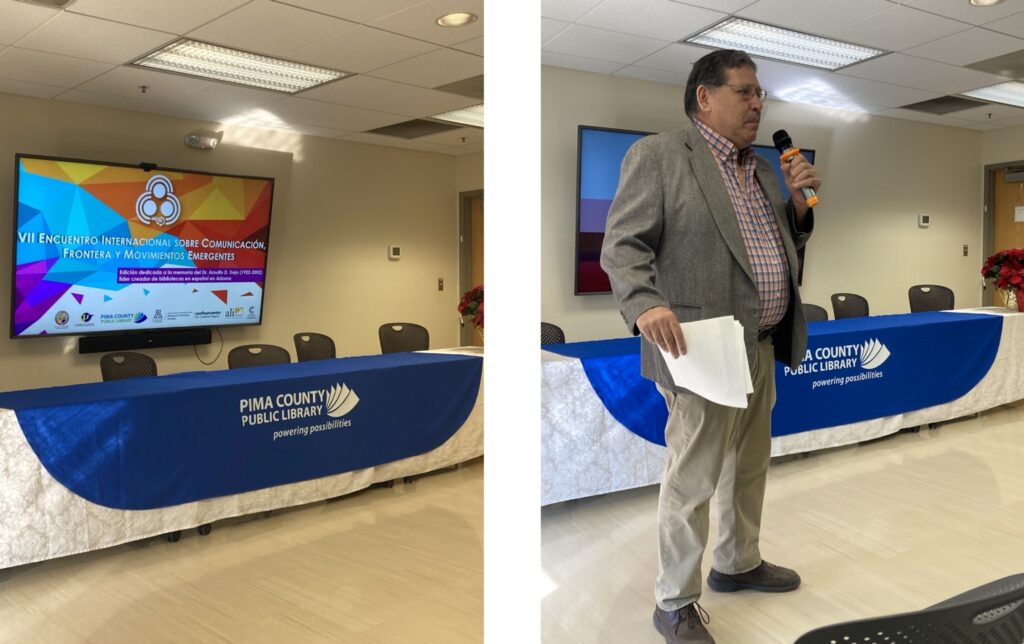
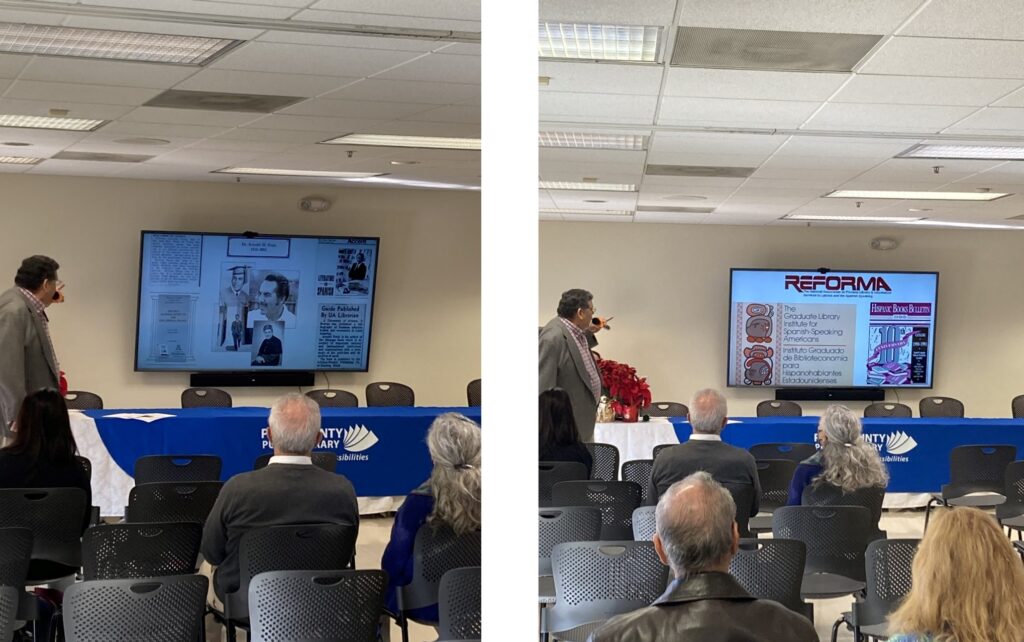
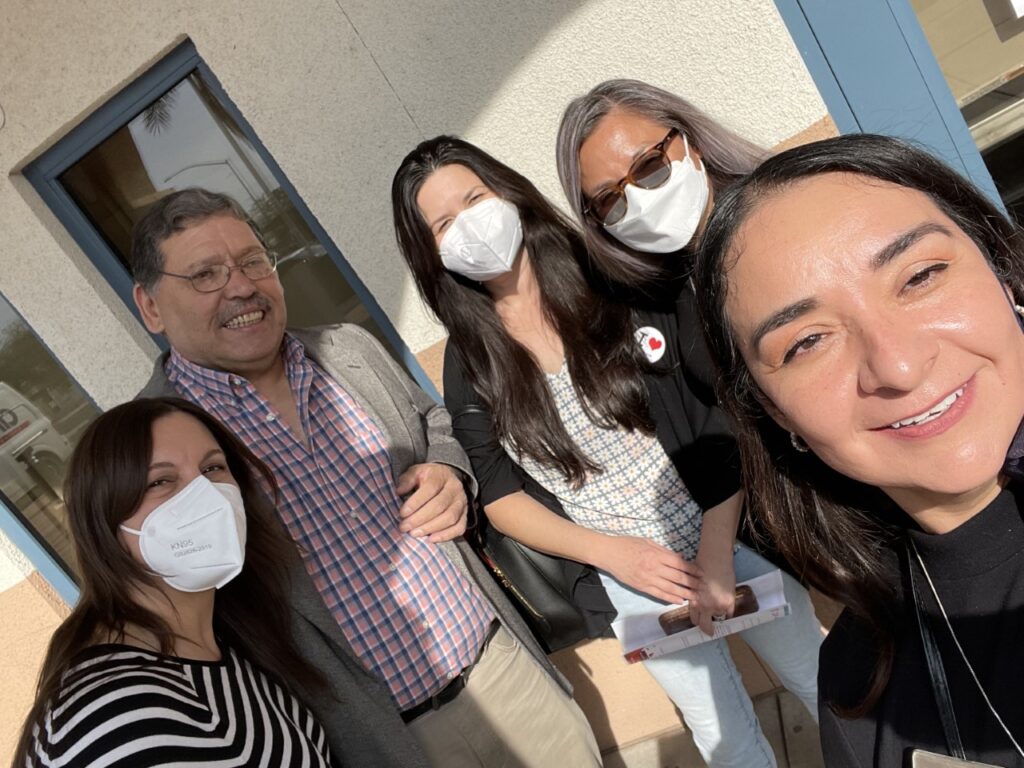
I opened my presentation with the following quote:
“According to Salvador Guerena and Edward Erazo, in their article, “Latinos and Librarianship“(source: Library Trends, V. 49, no. 1, Summer 2000), “of all the people who have contributed to Latino librarianship in this country, there is no one who has made a greater impact advancing this cause than Arnulfo D. Trejo, indisputably one of the country’s most illustrious and distinguished library leaders.”
I then presented the following slides, elaborating and adding context along the way:
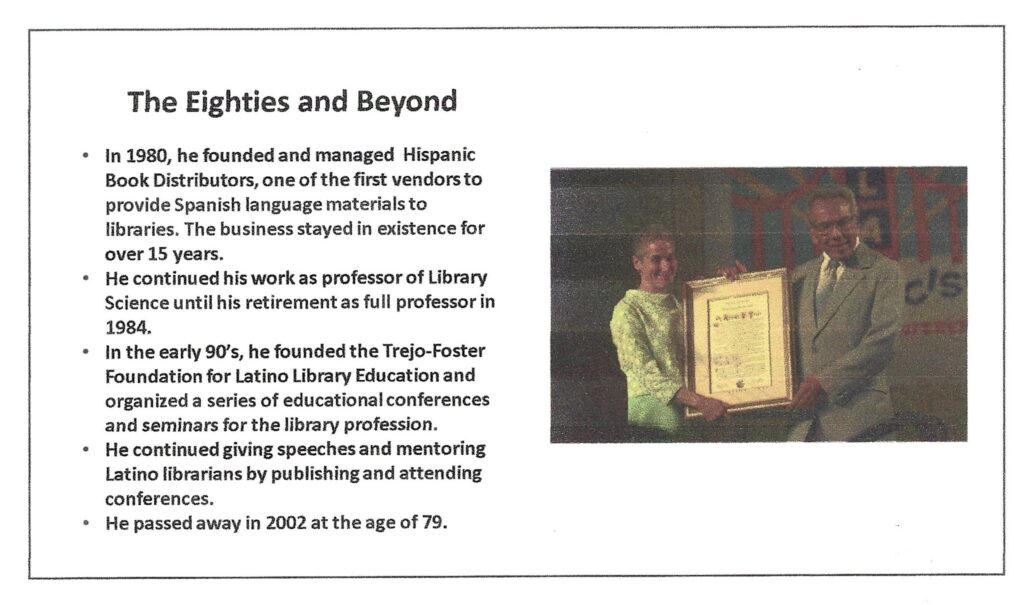
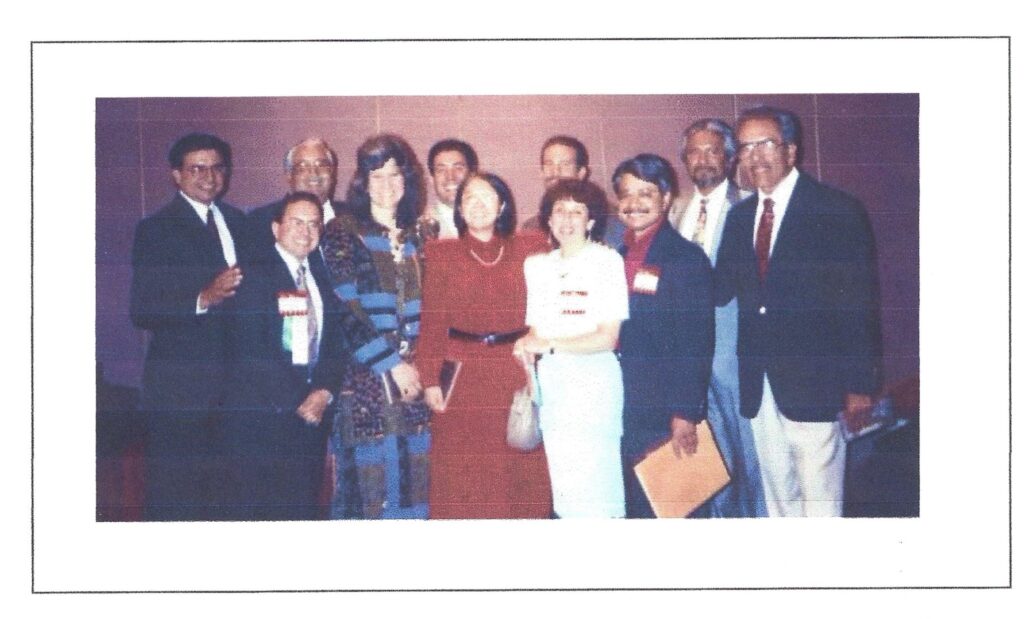

The following title, a work that Dr. Trejo edited, is available in full text online. See the page, The Chicanos: As We See Ourselves, and click on the download button to retrieve the full text of the book.
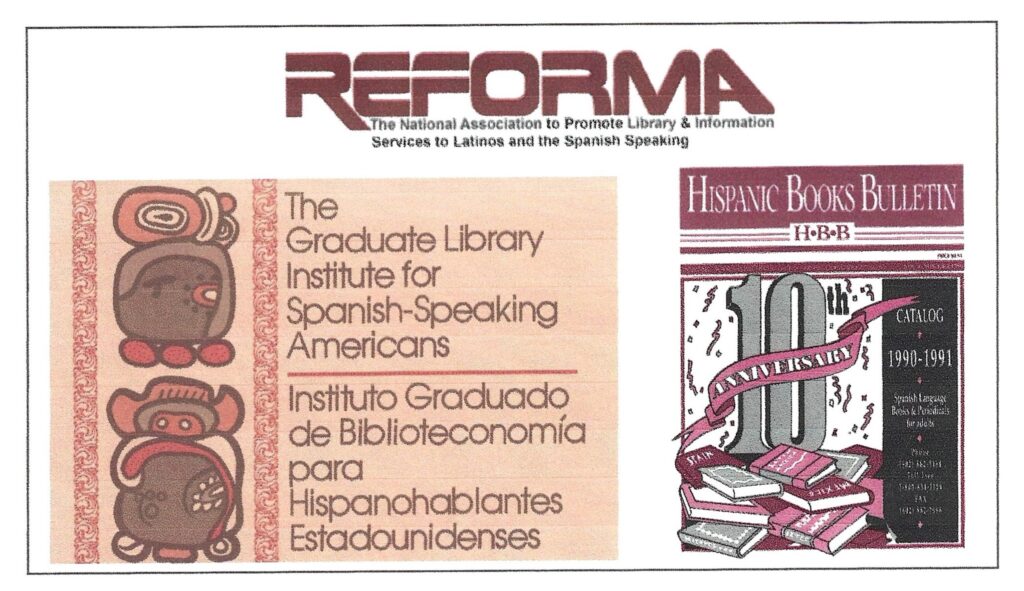
El Corrido de Don Arnulfo Trejo
by Bob Díaz
Voy a cantarles un corrido
De un hombre valiente y de verdad
Don Arnulfo Trejo se llamaba
y luchó para nuestra libertad
CORO:
Libertad pa’ ser Americano
Libertad pa’ hablar en Español.
Libertad pa’ ser educado
Libertad pa’ leer en Español.
Nació en México de veras
Pero a este lado su destino fue a quedar
Se creció en Tucson Arizona y desde joven luchó por la libertad
CORO:
Libertad pa’ ser Americano
Libertad pa’ hablar en Español.
Libertad pa’ ser educado
Libertad pa’ leer en Español.
Profesor y bibliotecario
Fue un hombre de grandísima vision
Padre de GLISSA y REFORMA
Le damos gracias por toda la nación
CORO:
Gracias Don Arnulfo Trejo
Gracias por su linda visión
Gracias Don Arnulfo Trejo
Gracias por su ardiente pasión
Vuela vuela palomita
Que ya se va acabando esta canción
Pero hay que siempre recordarse
¡La lucha continua, si señor!
¡La lucha continua, si señor!
==========================================================================
I’m very glad I was given the opportunity to do this program. It turned out to be another memorable occasion.
The 2005 Border Book Festival
In this post, I will share some of the memories I have of visiting Las Cruces and La Mesilla, New Mexico in 2005, when I attended the Border Book Festival in Mesilla for the first and only time. Before I begin, here are some brief overviews of each community:
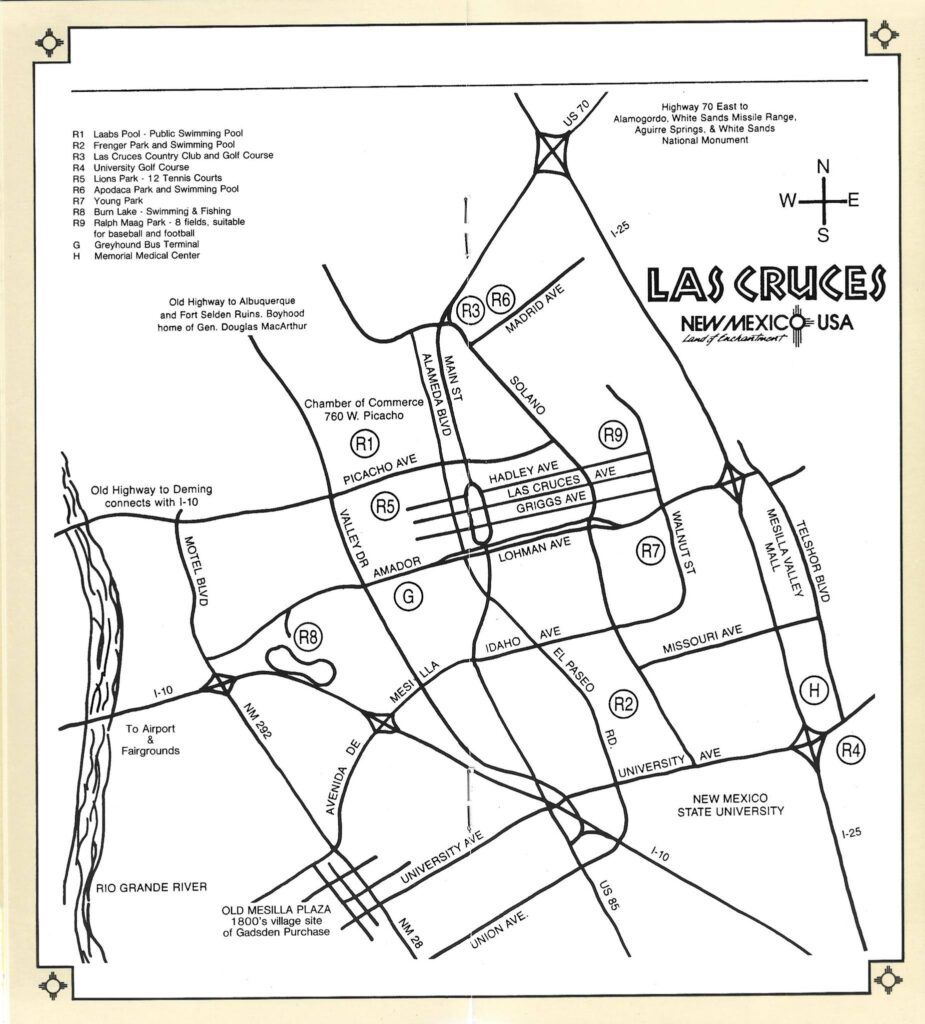

I had never knew much about Mesilla before, and attending a literary festival like this was quite out of the ordinary for me at the time, as my focus at work was primarily on music and the performing arts. Even so, I’ve always enjoyed Chicano literature and have been reading material in this genre since high school. I’m so glad I did attend, as I met Denise Chavez, whose novel, “Loving Pedro Infante” remains one of my very favorites, and I also got to visit La Mesilla and Las Cruces, two very interesting, historic communities just a mere four hours away from Tucson.

Border Book Festival History
March 24 2005
History and Scope of the Border Book Festival by Denise Chavez. (From a now-defunct website on the Border Book Festival that I found on the Wayback Machine).
The Border Book Foundation (BBF) is a 501 (c) (3) non-profit organization founded in 1995 by a group of writers, artists and community people committed to celebrating literature and the art of story in the southern United States–Northern México border region.
Based in Las Cruces and Mesilla, New Mexico, the Border Book Foundation believes that literature and the arts can bridge the many boundaries–racial, ethnic, generational, cultural, socio-economic, and gender-based–that divide our community. Ours is a grass roots organization that impacts its community by offering programs that are blueprints of positive communication, interaction and connection between people in our borderland region.
The Border Book Festival is a catalyst between many different groups and organizations including city, state and governmental agencies, schools, businesses and community centers. We are a bridge builder and model for positive exchange between diverse people in the borderland region.
Our annual book festival takes in April each year and features many activities for audiences of all ages including: Libros Y Más/Books And More, a Trade Show featuring national, regional and local presses and writers, a series of readings, workshops and panels, a school outreach program, as well as family storytelling events throughout the festival weekend.
The Premio Fronterizo honors a major American writer for their life long contribution to literature that transcends borders, real and imagined, and whose body of work has done much to add to the southwestern literary canon. Past winners of the Premio Fronterizo have included: Rudolfo Anaya, Sabine Ulibarrí, Tony Hillerman, Byrd Baylor, Leslie Marmon Silko, Barbara Kingsolver, Gary Soto, Sandra Cisneros, Luis Rodríguez, N. Scott Momaday, Luis Urrea and Ofelia Zepeda.
In addition, we present the Sunshine Community Service Award to a local business, organization or person who works to promote literature and the art of story at a grass roots level as well as the Cauthon Volunteer Service award to hardworking festival volunteers.
The cornerstone program of the Border Book Festival is the Emerging Voices Program, a series of hands-on writing workshops held throughout the year at various venues throughout the area.
The Border Book Foundation is committed to bringing audiences to writers and writers and book artists to audiences. Our programming is innovative, challenging, and transformative.
The BBF has had considerable impact in the Southern New Mexico border corridor as well as throughout the region. We have been touted in the New York Times as a “place where books matter,” and featured in Publisher’s Weekly as one of the top regional book festivals in the U.S.
The 11th annual Festival, Re-Inventing the Americas, will take place April 15-17, 2005 in Mesilla, New Mexico.
======================================================
I do not remember all the programs I attended, but I do remember going to the ones that featured the following writers:
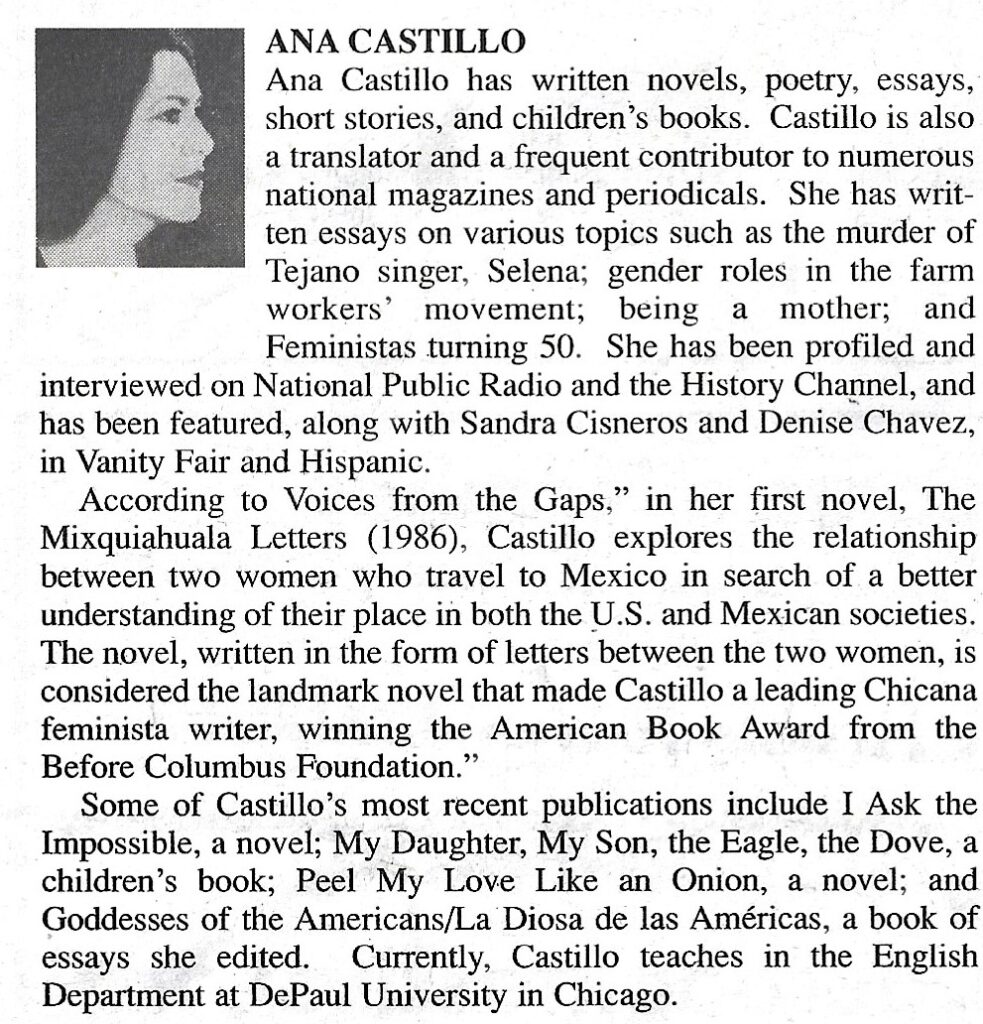
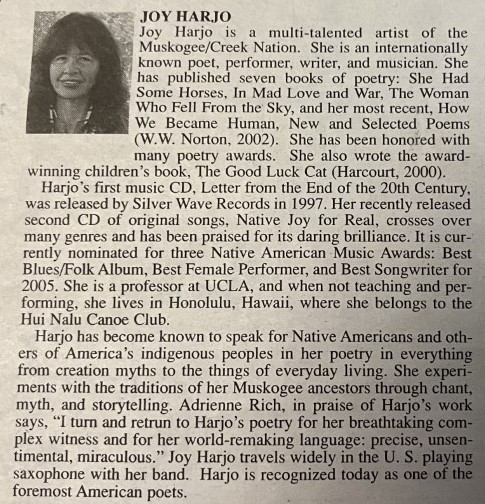
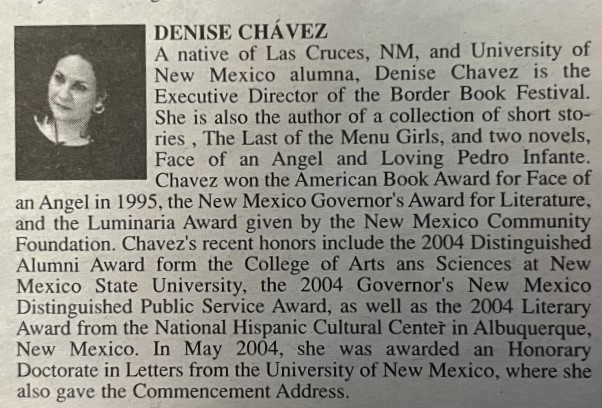
Our Commitment to the Community November 8 2005 (from a website on the Border Book Festival that no longer exists, found using the Wayback Machine)
The Border Book Foundation, with its annual Border Book Festival and expanding Cultural Center, will continue to bring the best of literature, literacy and storytelling to our multi-cultural, multi-generational audiences.
The Cultural Center of Mesilla/El Centro Cultural de Mesilla “C.C.M.” has filled a powerful need in our regional community. Not only do we offer a place for people to buy new, used and out-of-print multi-cultural books, bilingual books for children and adults and books in Spanish and English, we offer a haven and home to those who want to connect with border culture in a deep and meaningful way.
Located one block from the Mesilla Plaza, the Cultural Center was once home to a Mexican garrison building and later, the well-known and loved D.C. Frietze grocery store, run by Mesilla’s former mayor and our present landlord, Roberto Frietze.
The historic building is one of Mesilla’s oldest adobes and is permeated with sense of history and story that is the heart of our southwestern landscape. We offer a hot cup of coffee or tea and the opportunity to view the Lannan series of writer’s videos as well as previous festival documentaries including work by Lourdes Portillo on the disappeared women in Juárez or films by border filmmakers Paul Espinosa, Ray Santiestaban and Lisa Garibay.
Our book signings have reached hundreds of people who have never come out before to support literature. We have reached rural communities in Mesilla, Vado, Chamberino, La Union, Anthony, Derry and elsewhere. The Rudolfo Anaya book signing on December 10, 2004 brought over 400+ people to our Center who waited for hours to have Mr. Anaya sign their books. We had scheduled a reading but it was not possible because the line went down the street and past the acequia!
Book signings and readings for Benjamin Alire Sáenz and Denise and Susan Gonzales Abraham had over 100+ people each and many books were sold and new contacts made. The Gonzales Abraham book, Cecilia’s Year, written about the small farming community of Derry, New Mexico inculcated a new-found pride in “lo nuestro,” stories from our own backyard in southern New Mexico.
The Cultural Center’s workshop series has introduced the Art of Nopales (cactus) to many who only thought nopales was only the name of a Las Cruces restaurant. (“Nopalitos? You mean it means something?” someone said with wonder.) It is this lack of understanding about the basics of cultural life that have prompted us to address and educate and empower our audiences through our work at the Cultural Center of Mesilla and our on-going workshops and literary and arts events programming.
Our workshops have been myriad, challenging, informative and fun. They have included: Paper making with Martha Durán, The Care and Evaluation of Out-of-Print Books, with out-of-print book dealer, John Randall, Sacred Beads and Knots: The Significance of World Prayer Traditions Across the World, A Poetry Intensive with Miriam Sagan, ¡Familia! A family story writing workshop series with Denise Chávez, A writing workshop with Camino de Vida, an AIDS outreach organization, A Kid’s Art Day for 7-12 year-old with breakout sessions that included creative writing, dance, photography, drama and painting.
Upcoming workshops include: A Women’s Healing, Renewal and Transformation Retreat for women in the Gila Mountains, Vatos, a writing workshop for men, Senior to Senior, a poetry workshop for senior writers and writers in high school, mentoring and learning from each other, as well as a Feng Shui workshop.
At the root of all our work is the core belief that literature and the arts can empower and change lives.
The Cultural Center has hosted visits and receptions for many organizations and non-profits including the National PEN Women, the Executive committee of the American Library Association, The Association of University Women, The National Hispanic Cultural Center, Fr. Roy Bourgeois, human rights activist, among others.
You can expect the Border Book Foundation to initiate events for all ages that will reflect the best of our cultural history, legacy and strength of spirit. We see ourselves as a resource center and clearing house for the arts, as well as a place where community can find a way to understand itself through culture.
Future events will include workshops, panels, readings and book signings in English and Spanish, oral history gatherings, storytelling for children and families and any number of creative offerings that fit in with our mission to offer programs that are blueprints for positive communication, interaction, connection and healing between people in the borderland corridor.
We believe that literature and the arts can transcend the many perceived borders-racial, ethnic, generational, cultural, socio-economic, and gender-based-that divide our community.
==========================================
The following video was produced in 2014, several years after I attended the Border Book Festival. The Festival closed down for good just a year later, in 2015. I feel very lucky to have been to at least one of these momentous events.
Below are some of the monuments, shops and restaurants I visited in La Mesilla and Las Cruces in 2005. I was bummed that there were few, if any antique stores open at the time in Mesilla, but I did enjoy the two bookstores that were there, and the restaurants were really good too. I found another bookstore in downtown Las Cruces that was well-stocked with books and cds. If I recall correctly, I even found a Joy Harjo recording there. I also found a couple of antique stores out on Picacho Rd. and bought some records. I didn’t partake much of the night life, except once when I went to a nightclub in one of the local hotels. It was okay. Overall, I enjoyed the trip, even though it lasted just a few days. I knew I would go back again, but it would be over a decade before I made it back
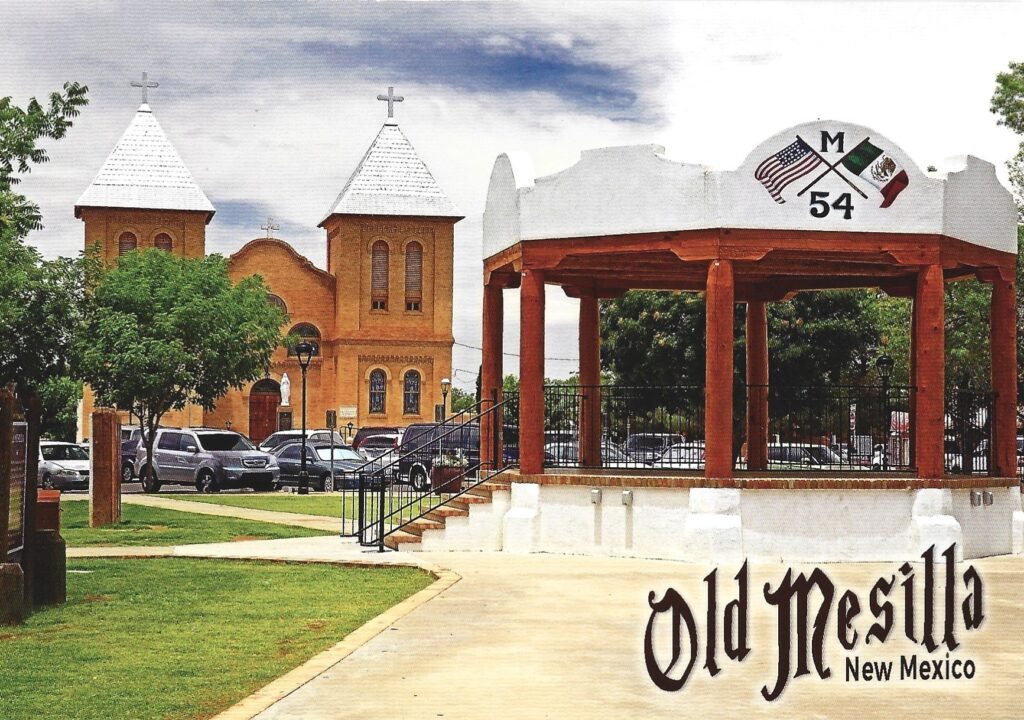
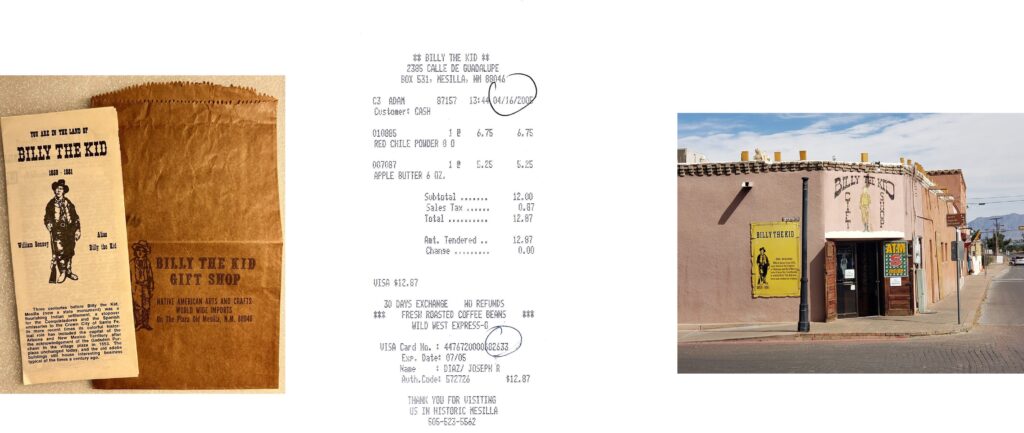
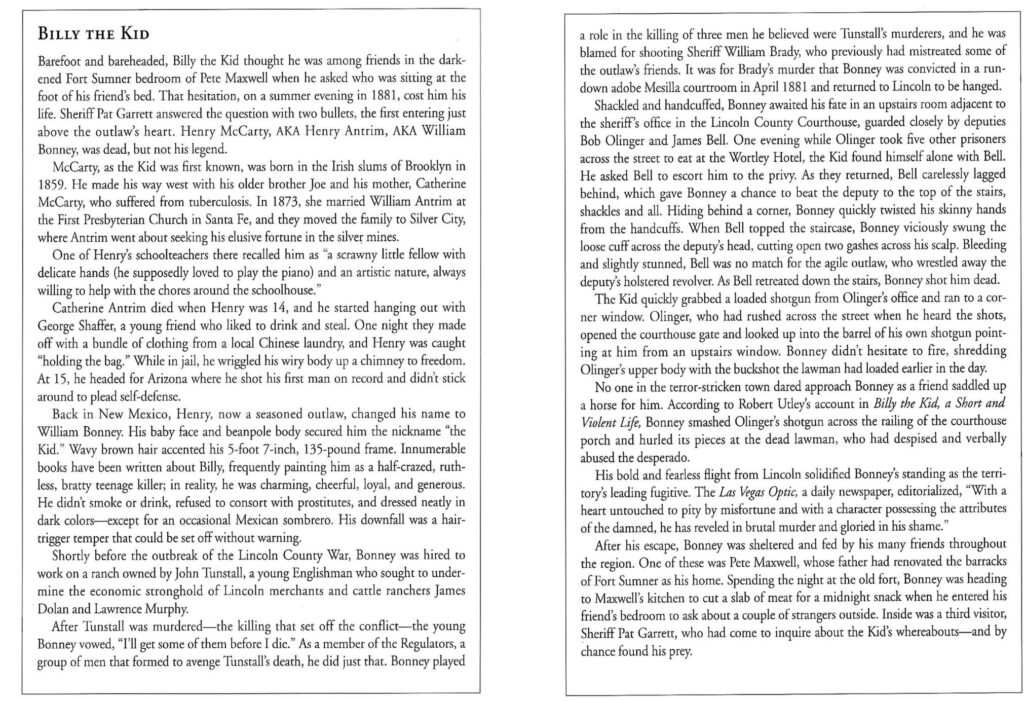

During this trip, I also explored Las Cruces, and found a couple of antique stores and a bookstore. I kept the following receipts and found business cards in an antiques directory for each store that I visited. These places are likely no longer in business.
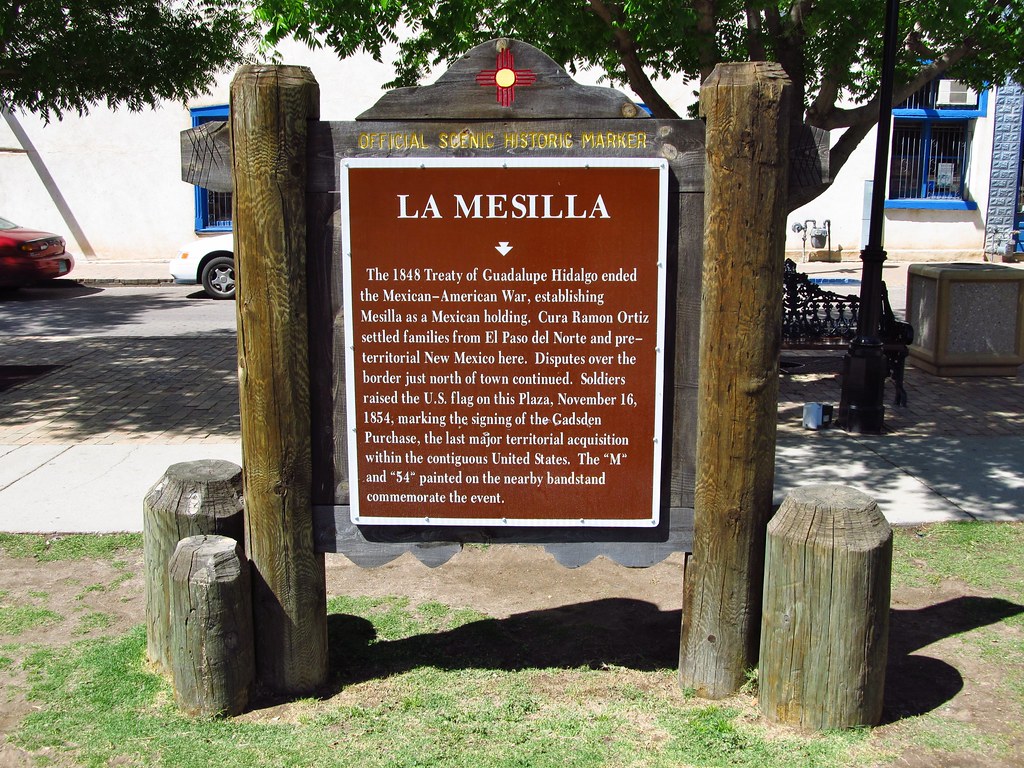
A few books about Mesilla, New Mexico
- Mesilla Comes Alive: A History of Mesilla and its Valley, by C.W. Ritter and Craig Holden. Las Cruces: Ritter Publications, 2014.
- The Mesilla Valley, An Oasis in the Desert, by Jon Hunner and Peter Dean. Santa Fe: Sunstone Press, 2008.
- Pioneers of the Mesilla Valley, 1823-1912. By P. Paxton.
- A Place As Wild As The West Ever Was: Mesilla, New Mexico, 1848-1872, by Mary D. Taylor Las Cruces: New Mexico State University Museum, 2004.
- La Posta: From the Founding of Mesilla to Corn Exchange Hotel to Billy the Kid Museum to Famous Landmark, by David Thomas. Las Cruces: Doc45 Publishing, 2013.
- Turmoil on The Rio Grande: History of the Mesilla Valley, 1846-1865, by William S. Kiser. College Station: Texas A&M University Press, 2011.
A few books about Las Cruces, New Mexico
- Celebrating 150 Years of Las Cruces History. Las Cruces: Las Cruces Sun-News, 1999.
- Las Cruces, by John Hunner. Charleston, SC: Arcadia Publishing, 2003.
- Las Cruces: A Photographic Journey (New Mexico Centennial), 1912-2012, by New Mexico State University. Las Cruces: FIG Publications, 2011.
- Las Cruces: An Illustrated History, by Linda G. Harris. Las Cruces: Arroyo Press, 1993.
- Las Cruces New Mexico 1849-1999: A Multicultural Crossroads, by Gordon Owen. Las Cruces: Red Sky Pub, 1999.
- Legendary Locals of Las Cruces, New Mexico, by Charlotte Tallman. Charlotte, SC: Legendary Locals, 2014.
